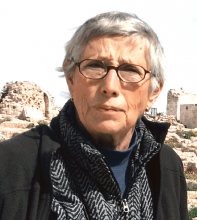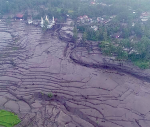You are here
Looking on as Daesh destroys world cultural heritage
Sep 02,2015 - Last updated at Sep 02,2015
The 2,000-year-old temple of Bel in the ancient city of Palmyra was largely destroyed by Sunday’s massive explosion in the ruins. Monday evening before satellite images of the devastation were broadcast by the UN, I managed to speak on the phone to Syria’s director of antiquities, Maamoun Abdulkarim, who was still clinging to the hope that reports that the walls and columns were still standing were true.
“We don’t know how much damage has been done in the temple,” he said. “We don’t know the size of the destruction, or the nature of the destruction. The situation is not clear, not like the temple of Baal Shamin [destroyed the week before]. We hope the function of the building as a church and a mosque will protect it.”
However, Daesh fighters who destroyed the Bel temple regard churches, mosques and other Muslim monuments as manifestations of heresy and idolatry.
The Bel temple in Palmyra and the temple at Baalbek in Lebanon constituted two of the greatest structures of antiquity in the Middle East, Abdulkarim said. Sunday’s explosion at the Bel temple left only one.
How long is the international community going to stand by and allow Daesh to continue its killing spree and massive destruction of the world’s cultural heritage?
The answer, of course, is indefinitely. The US-led anti-Daesh coalition could have prevented Daesh from entering Palmyra and the adjacent modern city of Tadmor at the end of May.
Daesh fighters drove in convoy along main routes from Deir Al Zor, a Daesh bastion, to reach Palmyra and nearby villages. But US warplanes did not go into action because Daesh was fighting Syrian government troops who had been under constant pressure from Daesh and other jihadist groups for months.
Daesh defeated the government forces, executed more than 20 captured during the fighting, massacred scores of local people who had been civil servants, murdered Khaled Al Asaad, the guardian of Palmyra, and blew up the Baal Shamin and Bel temples.
Neither did the coalition do anything against Al Qaeda affiliate Jabhat Al Nusra when it drove the government’s overstretched forces out of Idlib province and looted the museum in Idlib city, the only provincial museum that had not been cleared by the antiquities department of treasures before its capture by Daesh, a far more destructive force that the warriors of Hulagu, the Mongol khan who sacked Baghdad in 1258.
In January 2003, I visited Mustansiriya University, founded only 31 years before Hulagu’s barbarians swept into Baghdad, where I spoke to an expert on the period who said: “The Tigris went black with the ink from the books thrown into the river.”
Today, humanity should be in mourning the reduction of the Bel temple to dust by the super-Hulagus of Daesh, and world leaders should be planning how to wipe out the menace to the globe’s cultural heritage.
After establishing its “caliphate” in Raqqa in 2013, Daesh began its destruction of cultural heritage by smashing two highly prized Assyrian stone lion statues in the city’s park.
The lions had been removed from an archaeological site to the park in the 1980s so they could be admired by citizens of the city.
Daesh and similar jihadist groups operating across the world have taken their cue from the Taliban which in March 2001 blew up the Bamiyan Buddhas, two 6th century statues of standing Buddha carved into a cliff side in the Bamiyan Valley in Afghanistan.
In Iraq, after taking control of Mosul in June 2014, Daesh fighters smashed 90 statues in the museum and burned 6,000 manuscripts and books in the library, blew up and bulldozed the ruins of the ancient Assyrian city of Nimrud, dating to the 13th century BC, flattened the 2nd century site of Hatra, and sacked 8th century BC Dur-Sharrukin (Fortress of Sargon).
By July this year, 20 per cent of Iraq’s archaeological sites had fallen under Daesh control.
Daesh has also systematically wrecked Sunni and Shiite mosques (including shrines dedicated to the prophets Jonah and Daniel), churches, tombs and mausoleums, and looted archaeological sites.
In Mali, Daesh look-alikes attached to Al Qaeda destroyed 15 of Timbuktu’s historic mausoleums, buildings dating to the 15th and 16th centuries, when the city was an economic, intellectual and spiritual centre.
Books and valuable manuscripts in private libraries were also burned.
In Libya, jihadists destroyed mausoleums of eminent scholars and saints. The international response has been, “words, words, words”, to quote Liza Doolittle (a significant last name) in the film “My Fair Lady”.
As usual, UNESCO, which is supposed to offer protection to cultural heritage, has condemned “the repeated and deliberate attacks against cultural property”, but did nothing.
UNESCO Director Irina Bokova has called the destruction in Mosul and Palmyra war crimes.
In 1974, UNESCO shelved a detailed report on the destruction by Turkish troops and local looters of a report commissioned by the organisation. The report remained secret for decades.
US Secretary of State John Kerry did what diplomats always do: spoke of studying the situation. He said the State Department was working with the American Schools of Orient Research to “comprehensively document the condition of, and threats to, cultural heritage sites in Iraq and Syria to assess their future restoration, preservation and protection needs”.
Kerry’s futile words, of course, come from the country that has done nothing to preserve or protect Iraq’s cultural heritage since the disastrous 2003 occupation that gave birth to Al Qaeda in Iraq, which matured into Al Qaeda in Iraq and Syria and proclaimed itself Daesh.
The thousands of refugees from Syria and Iraq crossing the Mediterranean into Europe are, like the region’s cultural heritage, victims of Daesh and the jihadists now fighting the governments in these two countries.
Therefore, failure to deal with the jihadist groups is certain to swell this peaking wave of refugees, whose departure is certain to undermine the reconstruction and recovery of these countries once the conflicts that grip them are brought to an end — if ever.












